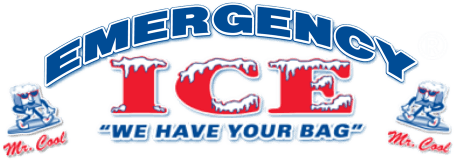Summertime is finally here! For the next few months, we will be spending less time indoors and more time enjoying the warm, sunny weather – which means it’s time to break out the ice cooler. An American family summer staple, the ice cooler is used to keep food and drinks as cold as possible. Coolers are commonly filled with bags of packaged ice, which can keep the inside cool for a short while. However, the ice melts quickly, leaving you with soggy food sloshing around the cooler just a couple of hours into the day. Whether you’re camping, fishing, spending a day at the beach, picnicking, or embarking on a road trip, no one enjoys a wet and mushy sandwich. Thankfully, your favorite emergency ice provider has discovered a great alternative: dry ice.
What is dry ice?
Essentially, dry ice is frozen carbon dioxide. Unlike regular ice cubes made of water, carbon dioxide does not go through a liquid stage as it cools from a gas stage to a solid stage. Instead, it “sublimates”, changing directly from solid to vapor. Because carbon dioxide freezes at a much lower temperature than water, it is also extremely cold, reaching temperatures below -100°F. It is colorless, yields an acidic odor, and is non-flammable.
Dry ice is used in many different ways, including commercial, industrial, and scientific applications. However, it’s non-toxic, dry, and exceptionally cold properties make it particularly useful for keeping ice cooler contents cool (and even frozen!) for 18-24 hours.
–
The Perfect Ice Chest
The keys to packing an ideal ice chest to take along any of your summer adventures are its contents and assembly. Without the right contents, your ice chest may be cold but poorly supplied and improper assembly could lead to the undesirable freezing of your food and/or packaging.
Dry ice
Contents

To pack an ice chest with dry ice, you will need:
- Dry ice, of course! You will want one 10-pound square for every 15 inches of cooler space. This can be purchased from a local ice company, many of which even provide ice delivery straight to your door.
- Towels and/or newspapers to create levels. This will be used for the proper assembly of your food so that you can keep them at the level of coolness you desire.
- Food and drinks you’d like to take along. Include bread and deli meat (or prepared sandwiches), fruit, veggies, yogurt, condiments requiring refrigeration, as well as your family’s favorite drinks and juices. You can even add ice cream, popsicles, and other yummy frozen treats.
Assembly
- Wrap the chunk of dry ice in several thicknesses of newspaper or towels, and place at the bottom of the chest. Be sure not to set the ice directly on the inside of your cooler as it will crack the plastic interior. Depending on the amount of frozen items you are packing, you could move the ice block to one side of the cooler. Handle the dry ice with caution as direct contact can cause burns.
- Immediately above the covered dry ice, place any items you would like to keep frozen. Cover the frozen food layer with another towel. This will contain the coldest part of the chest, preventing non-frozen items from freezing.
- Top the “freezer” level of your chest with all of the items that you wish to keep cool but not frozen. Be sure to isolate any bottles or aluminum cans of liquids as far away as possible from the dry ice. It is best to place all of your drinks in a soft-sided cooler inside of the ice chest for easy access and to prevent accidental freezing.
Vapors need to escape from beneath the cooler lid, so it’s important to allow them space to do so. Once your ice chest is packed and ready to go, place the unlatched cooler in the trunk of your car where the escaping gas can ventilate safely. If you must place the chest inside of your car, be sure to crack open the window closest to it and set your car’s heating or cooling system set to fresh air and not recirculation mode.
